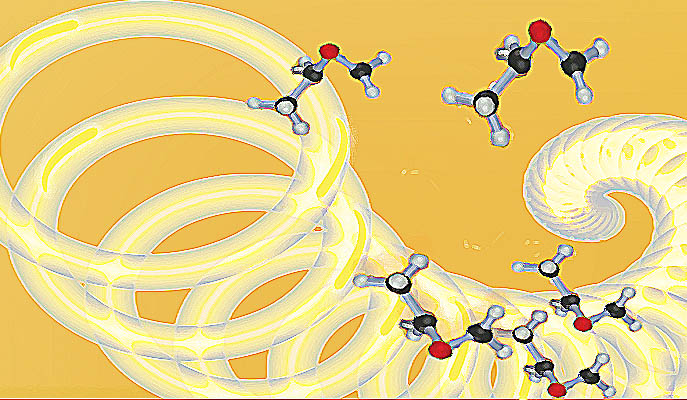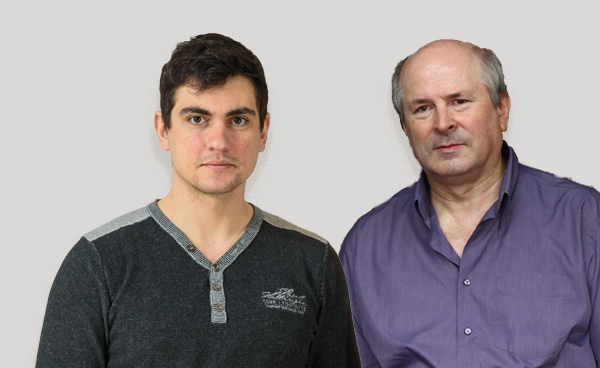Are you a journalist? Please sign up here for our press releases
Subscribe to our monthly newsletter:

The important molecules on Earth often come in one of two versions, left- or right-handed. But, for reasons that are still unknown, living systems tend to prefer one type of handedness – or chirality – over the other. DNA, for example, is normally a right-handed helix, whereas protein building blocks are, for the most part, left-handed. Living organisms tend to be extremely picky in their use of chiral substances: A drug’s effectiveness can depend on the chirality of its molecules. Much effort is therefore invested in developing improved methods for identifying the chirality of compounds in mixtures, and for sorting them out.
Now researchers have succeeded in directly manipulating chiral molecules with light – a goal that had been long sought but never previously attained. An international research team bringing together physicists from the Weizmann Institute of Science and the University of British Columbia managed to selectively orient left- and right-handed chiral molecules in opposite directions, using laser pulses. This new approach to the control of chiral molecules may, in the future, lead to innovative ways of separating chiral substances.
corkscrew-shaped laser pulses whose electric field rotates at increasing speed, ultimately reaching ten trillion revolutions per second
“Existing methods for sorting these molecules usually rely on selective crystallization or on chemical reactions with chiral catalysts in a solution,” says Prof. Ilya Averbukh of Weizmann’s Chemical and Biological Physics Department, who developed the theoretical foundations for the experiment with graduate student Ilia Tutunnikov. “Our approach, in contrast, is ultra-fast, and it can work at concentrations much lower than the chemical methods ‒ for example, when the target compound is available only in the form of a rarefied gas.”
The substance used in the study, an organic compound called propylene oxide, made headlines back in 2016 when it became the first – and thus far, the only – chiral molecule to be found in interstellar space. Its discovery boosted theories that the predominance of certain types of chirality in living systems may be rooted in the way that stars and planets are born.
In the new study, reported recently in Physical Review Letters, the researchers changed the orientation of propylene oxide molecules using an advanced laser technology known as an optical centrifuge. Much like the centrifuge that spins clothes in a washing machine, this device spins molecules using a specially-designed form of “twisted” light: corkscrew-shaped laser pulses whose electric field rotates at increasing speed, ultimately reaching ten trillion revolutions per second.

Averbukh and his colleagues had the idea that if a mix of chiral molecules were loaded into an optical centrifuge, the molecules would be trapped in different ways by the rotating electric field, depending on their handedness. This is exactly what happened in the experiments. The molecules were caught by the centrifuge’s field and then became oriented perpendicularly to the plane of the centrifuge’s rotation, with left-handed molecules pointing in one direction and right-handed ones in another. To confirm these findings, the researchers used a methodology called Coulomb explosion to break the molecules into their components, which enabled them to create images of the flying-away molecular fragments and determine which way the molecules had been oriented.
Though a relatively small number of chiral molecules were selectively oriented in this study, the observation sufficed to prove that – in principle – controlling them with light is possible. In the future, it may be possible to develop this method not only for sorting chiral molecules but perhaps even for inducing or speeding up chemical reactions, which critically depend on the molecules being properly oriented toward one another.
The experimental team was led by Prof. Valery Milner of the University of British Columbia – who had earned his PhD at Weizmann – it included Dr. Alexander A. Milner – who had also worked at Weizmann in the past – and graduate students Jordan A. M. Fordyce, Ian MacPhail-Bartley and Walter Wasserman.
Prof. Ilya Averbukh is the incumbent of the Patricia Elman Bildner Professorial Chair of Solid State Chemistry.